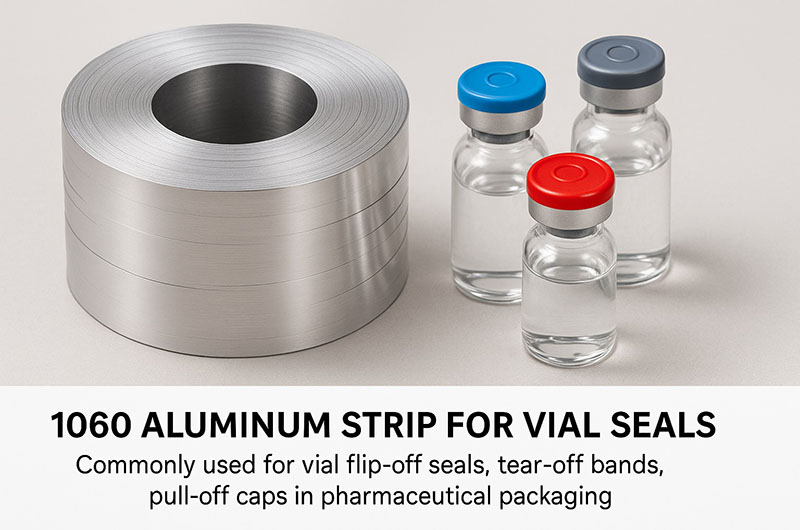The 1060 aluminum strip is widely used in pharmaceutical vial sealing due to its high purity, excellent corrosion resistance, and outstanding processing performance. Its exceptional sealing capability and anti-oxidation properties make it an ideal packaging material for the pharmaceutical industry, especially in the production of small vial closures and tamper-evident caps.
1060 aluminum strip, with its high purity, excellent workability, and outstanding sealing and barrier properties, has become an ideal material for vial seals. Its soft O temper combined with adhesive backing technology ensures efficient and sterile packaging during pharmaceutical filling processes.
The 1060 aluminum strip used for vial sealing is a soft pure aluminum product. Due to its excellent corrosion resistance, it is highly suitable for pharmaceutical vial caps. Its formability, corrosion resistance, sterilization compatibility, and cost-effectiveness are all well recognized. This product is available in various tempers and surface treatments and adheres to strict dimensional standards to ensure reliable sterile packaging performance.

1060 aluminum is a commercially pure aluminum alloy with an aluminum content of ≥99.6% and extremely low impurity levels (e.g., iron content ≤0.35%, silicon content ≤0.25%), ensuring its high chemical stability and compatibility with pharmaceutical substances.
Vial Seals 1060 Aluminum Strip Specifications and Tolerances
| Parameter | Range |
| Thickness | 0.15–0.50 mm (±0.005–0.010 mm tolerance) |
| Width | 50–1, 500 mm (+0.5 to +1.0 mm tolerance) |
| Temper | O (soft, high formability), H22/H24 (strain-hardened, moderate strength) |
| Coil Core ID | 76 mm, 152 mm, 200 mm, 300 mm |
Vial Seals 1060 Aluminum Strip Surface Treatments
Available options include:
- Plain mill finish
- DOS oil lubrication
- Chromate conversion coating
- Lacquered (single-sided/double-sided)
- Color coatings (e.g., gold, white, red, blue, black)
Used to enhance adhesion in laminates, improve aesthetics, or provide corrosion protection.
| Surface Treatment Type | Description |
| Plain Mill Finish | Bare aluminum surface, suitable for basic sealing applications |
| DOS Oil Lubrication | Coated with Dioctyl Sebacate lubricant to reduce friction during stamping |
| Chromated Finish | Chemical passivation forms a chromate film to enhance corrosion resistance, suitable for long-term storage and sterilization environments |
| Lacquered/Coated | Single- or double-sided coatings, available in gold, white, blue, etc., for brand recognition or protective barriers |
Additional surface treatments available upon request (e.g., anodizing, heat-seal coatings, UV coatings, etc.).
Vial Seals 1060 Aluminum Strip Properties
- Corrosion Resistance: Naturally resistant to oxidation and chemical degradation, which is critical to maintaining drug integrity
- Formability: Excellent ductility allows for deep drawing into complex seal shapes like flip-off or pull-off caps without cracking
- Sterilization Compatibility: Withstands autoclaving, gamma radiation, and mercuric chloride tests without compromising mechanical properties
- Non-toxic: Compliant with FDA and EU directives for contact with food, pharmaceuticals, and cosmetics
- High Purity: 1060 aluminum alloy contains more than 99.6% aluminum, ensuring extremely high purity. This high-purity aluminum offers excellent corrosion resistance and effectively resists chemical components in drugs, preventing contaminants from entering the vial and preserving the effectiveness and stability of the medication.
- Workability: 1060 aluminum alloy has good ductility, enabling consistent formability in high-speed stamping processes without cracking or tearing. This is especially advantageous for mass production of complex cap designs.
Vial Seals 1060 Aluminum Strip Mechanical Properties
| Temper | Thickness (mm) | Tensile Strength (MPa) | Elongation (%) | Earring Rate (%) |
| O | 0.15–0.32 | 55–95 | 15 | ≤6 |
| O | >0.32–0.50 | 55–95 | 18 | ≤6 |
| H22 | 0.40–0.50 | 75–110 | 6 | ≤5 |
Wear Resistance:
≤6% (O temper), ≤5% (H22 temper)
Flatness/Straightness:
Camber ≤5mm; limited surface waviness (e.g., height ≤3mm over 1 meter)
Reasons Why Vial Seals 1060 Aluminum Strip is Favored
- High purity and excellent corrosion resistance
- High ductility, suitable for deep drawing and tight sealing
- Cost-effective and widely applicable
- Compatible with various sterilization methods
- Consistent thickness/flatness tolerance, ideal for precision sealing applications
Vial Seals 1060 Aluminum Strip Applications
Vial Seals 1060 Aluminum Strip Pharmaceutical Applications
1060 aluminum strips are engineered for:
- Flip-Off Vial Seals: Tamper-evident caps for injectables/vaccines
- Pull-Off Caps: Easy-open designs for oral liquid bottles
- Aluminum-Plastic Composite Seals: Combined with plastic components for infusion bottles
- Universal Tear-Off Designs: Customizable scorelines for varied opening mechanisms
Pharmaceutical Sealing Application Features of 1060 Aluminum Strip
Functional Advantages
- Barrier Property: Effectively blocks oxygen, moisture, and microorganisms to protect the stability of injectables
- Seal Strength: Passes air-tightness tests after crimping, in compliance with "Pharmaceutical Aluminum Foil Bag Sealing Standards"
- Lightweight: Reduces overall packaging weight and transportation costs
Industry Compatibility
- Suitable for sealing small-diameter containers such as vaccine vials and ampoules
- Customizable width (commonly 94mm, etc.) to match automated filling production lines
Vial Seals Aluminum Strip 1060 Chemical composition
| Chemical composition Wt(%) | |||||||||
| Alloy | Si | Fe | Cu | Mn | Mg | Zn | Ti | Others | Al |
| 1060/A1060 | ≤0.25 | ≤0.35 | ≤0.05 | ≤0.03 | ≤0.03 | ≤0.05 | ≤0.03 | 0.03 | Remainder |
Vial Seals 1060 Aluminum Strip Manufacturing and Quality Control
Manufacturing Process: Melting → Hot Rolling → Annealing → Slitting → Surface Treatment → Coiling
The final coil is slit into widths matching vial diameters and wound on 76mm/152mm cores
Quality Control
- Flatness Standard: Wave height ≤3.0mm per meter to prevent jamming in high-speed stamping machines
- Defect Control: Scratches, stains, or lubricant residues are strictly prohibited; surface must pass cotton pad cleanliness test
- Packaging: Fumigated wooden boxes with moisture-proof film, paper pads, and steel strapping to prevent transport damage
